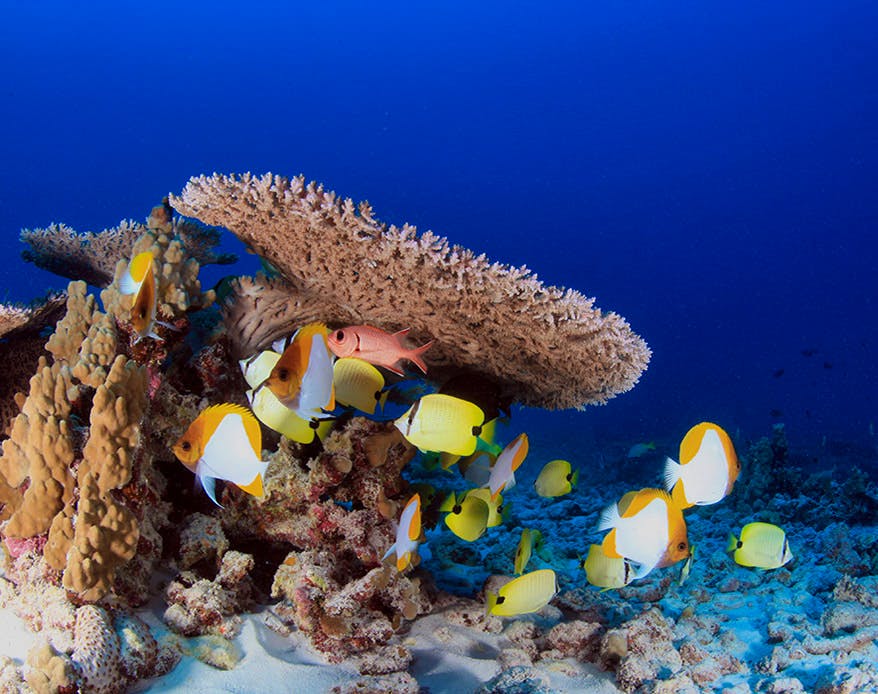Coral reefs occupy a special place in the human imagination, with millions of divers, tourists, and fishers traveling across the globe to visit reefs. The Great Barrier Reef Park alone attracts between 1.5 and 2 million tourists a year. The economic value of reefs are huge: one 2017 scientific paper estimated that coral reefs provided a global economic value of nearly $36 billion dollars per year through tourism alone. Coral reefs provide significant additional economic value through ecosystem services such as habitat for fisheries, storm surge protection, and water quality improvement.
But the value of reefs cannot be adequately captured in terms of dollars. Reefs are an important part of our cultural heritage. They are also biodiversity hotspots, and while they make up only about one percent of the ocean floor, they provide habitat or food for approximately a quarter of the world’s ocean species.
Despite their importance, human activities at both the global and local scale pose an existential threat to the world’s coral reefs. The Intergovernmental Panel on Climate Change released the Special Report on the Ocean and Cryosphere in a Changing Climate two weeks ago with a stark message: for decades, the world’s oceans have been “taking the heat” for climate change, absorbing over 90% of the heat and nearly a third of the carbon dioxide from greenhouse gas emissions. Climate change is perhaps the most serious threat, as increasing ocean temperatures can stress corals, causing them to expel the photosynthetic organisms that many corals rely on to provide food (and which provide much of their vivid colors!). Without these organisms living inside them, corals typically turn white and die, a process known as coral bleaching.
Heat stress is not the only effect of climate change that threatens global coral reefs. Much of the carbon dioxide we pump into the atmosphere dissolves in the ocean, making the ocean more acidic. Stony corals – the kind of corals that build reefs – then have trouble building or maintaining their shells, resulting in lower reproduction and higher vulnerability to damage.
In addition to global climate change, local human activities can hurt coral reefs. Coral reefs are often highly vulnerable to changes in water quality, and human activities often increase water pollution off the coast. Overfishing can disrupt coral ecosystems, removing species that help clear plankton off the corals themselves. Perhaps not surprisingly, several corals have been designated as threatened or endangered under the Endangered Species Act.
Prior to joining Defenders of Wildlife, I worked on marine and coastal conservation issues in Miami, which drove home for me the importance of holistic approaches to conservation. Just offshore of the city is the Florida Reef Tract, the only living coral barrier reef in the continental United States and one of the largest such reefs in the world. Since the 1970s, most of the Florida Reef Tract has been lost, much of it due to human activities. Dredging carried out by the U.S. Army Corps of Engineers killed as many as half-million corals right off Miami’s coast. Recently, a disease has been sweeping across the Florida Reef Tract, as well as through other reefs in the Caribbean. Though we still do not know the cause, climate change and human-caused nutrient runoff may be causing or exacerbating the outbreak.
With all these threats, how do we save coral reefs from extinction? As with all conservation, solutions must address both local and global threats. This is a principle that Defenders of Wildlife has been following across the landscapes, species, and habitats we have worked on for over 70 years. At the global level, reducing emissions of greenhouse gasses like carbon dioxide and methane can mitigate coral bleaching and ocean acidification. Defenders of Wildlife is fighting for wildlife-friendly renewable energy around the country, promoting wind and solar and helping to reduce emissions. On the local level, Defenders is fighting to protect marine habitats, like the Northeast Canyons and Seamounts Marine National Monument and Papahānaumokuākea Marine National Monument, since protected areas are more resilient and more diverse. Safeguarding coastal water quality and preventing dredging, shipping, and recreational activities from causing the kind of damage the U.S. Army Corps of Engineers’ dredging projects. Applied conservation projects, such as transplanting new corals into degraded areas and developing heat-resistant corals in the laboratory better able to cope with warming seas, also offer potential ways to restore and safeguard reefs.
As coral reefs worldwide face the risk of human-facilitated extinction, it is our responsibility to do what we can to reverse and mitigate the stresses we cause. Failing this, there is a very real chance that coral reef ecosystems will go globally extinct by the end of the century.












Follow Defenders of Wildlife
facebook bluesky twitter instagram youtube tiktok threads linkedin